Before we start, let’s address some common challenges people face:
Troubleshooting Guide: Common Ebook Creation and Selling Problems

| Challenge | Solution | Prevention Tips |
|---|---|---|
| Formatting issues across devices | Use standard formats (EPUB/PDF) and test on multiple devices before publishing | Use professional templates or dedicated ebook creation software like Calibre |
| Low sales despite good content | Revisit your marketing strategy, book cover, and sales copy | Research your market thoroughly before creating; build an audience first |
| Pricing uncertainty | Test different price points with small audience segments | Research competitor pricing in your niche and position accordingly |
| Writer’s block or content creation fatigue | Repurpose existing content; use AI tools to assist with drafting | Create a detailed outline before starting; work in short, scheduled sessions |
| Technical barriers in creation | Use user-friendly tools like Canva or hire help for complex elements | Start with simpler formats and gradually add complexity as you learn |
| Limited reach and visibility | Implement a multi-channel marketing approach | Build your email list and social presence before launching |
| Negative reviews affecting sales | Address legitimate concerns in updated versions | Get feedback from beta readers before publishing |
| Difficulty standing out in crowded niches | Develop a unique angle or perspective; focus on specific sub-niches | Research competition thoroughly before creating; identify content gaps |
PS. For niche-specific ebook strategies, go here.
–
The global ebook market is projected to experience steady growth in the coming years. According to Statista, global ebook revenue is expected to reach approximately $14.92 billion in 2025, with an annual growth rate (CAGR) of 1.27% leading to a market volume of $15.69 billion by 2029.
I’ll try my best to walk you through every step of the ebook process—from conceptualizing your ebook to marketing it successfully.
Whether you’re a first-time author or looking to expand your digital product lineup, you’ll find actionable strategies to create and sell an ebook that resonates with your audience.
–
=== Part 1: CREATING Your Ebook ===
Choosing Your Ebook Topic

The foundation of a successful ebook begins with selecting the right topic. Your ideal topic should exist in the sweet spot between your expertise, your audience’s needs, and market demand.
Start by brainstorming topics you’re knowledgeable and passionate about. Passion alone isn’t enough—your topic needs to solve a specific problem for a defined audience.
Research what’s already selling in your niche using platforms like Amazon Kindle, or searching “[your topic] ebook” to see what competitors offer. Look for content gaps where your unique perspective or specialized knowledge could provide additional value.
Market Validation Techniques:
Use keyword research tools like Ahrefs or Semrush to gauge search volume for topics
Check question-based platforms like Quora or Reddit to identify common questions in your niche
Survey your existing audience about their biggest challenges
Analyze Amazon bestseller lists in your category to spot trending topics
Remember that highly specialized topics often convert better than broad ones. E.g. “Instagram Marketing for Pet Photographers” will likely convert better than “Social Media Marketing.”
Leveraging Your Existing Content
Creating an ebook doesn’t mean starting from scratch.
Take inventory of your content assets—blog posts, newsletters, podcast transcripts, videos, social media posts, and presentations. Look for thematic connections between pieces that could form chapters.
Organize your content into logical groupings and identify gaps that need fresh material. The 80/20 rule often applies here—aim to repurpose about 80% of existing content while creating 20% new content to tie everything together.
Content Transformation Tips:
Expand brief blog posts with additional examples, case studies, or actionable steps
Convert list-style articles into detailed how-to guides
Transform step-by-step guides into worksheets or templates
Add context and transitions between repurposed content pieces
Update statistics and references to ensure accuracy
Revise content to maintain a consistent voice throughout the ebook
Nathan Barry, founder of Kit, built his initial six-figure ebook business by strategically repurposing and expanding his blog content into comprehensive guides.
Planning Your Ebook Structure
A well-structured ebook keeps readers engaged and delivers on its promise. Start by creating a compelling hook that clearly articulates the transformation your ebook provides.
Draft your table of contents with a logical progression that takes readers from their current situation to their desired outcome. An effective structure typically includes an introduction, core content chapters, and a conclusion with next steps.
For non-fiction ebooks, consider organizing chapters in one of these proven formats:
Problem → Solution
Beginner → Advanced
Chronological progression
Step-by-step process
Structure Planning Elements:
Write a compelling introduction that establishes credibility and sets expectations
Create consistent chapter formats with clear learning objectives
Include practical examples that illustrate key concepts
Add action steps or summaries at the end of each chapter
Consider adding bonuses like worksheets, templates, or checklists to increase value
Your structural plan should also include a realistic timeline for completion with milestones for drafting, designing, editing, and formatting your ebook.
Tools for Creating and Editing Your Ebook
The right tools can dramatically streamline your ebook creation process. Choose based on your technical comfort level, existing workflows, and desired output formats.
Free Writing and Editing Tools:
Google Docs: Excellent for cloud-based writing with real-time collaboration
Microsoft Word Online: Familiar interface with basic formatting options
Notion: Flexible workspace for organizing and writing content
Paid Software:
Scrivener: Purpose-built for long-form writing with excellent organization features
Vellum (Mac only): Creates beautifully formatted ebooks with minimal effort
Web-based Tools:
Reedsy Book Editor (free): Purpose-built for book formatting
Atticus: Combines writing, formatting, and collaboration tools
AI Writing Assistants:
ChatGPT: Helps overcome writer’s block and generates draft content
Sudowrite: Fiction-focused writing assistant for creative projects
For beginners, starting with familiar tools like Google Docs or Word is recommended. You can always export to specialized formatting tools later in the process.
Writing and Expanding Your Content
With your structure and tools in place, it’s time to develop your content. Focus on filling gaps in your repurposed material and creating a consistent reader experience.
Write in a conversational tone that makes complex information accessible. Most successful ebooks are written at a 7th-9th grade reading level regardless of the complexity of the subject matter.
Break down complex concepts with examples, analogies, and visual elements. Use the “explain like I’m five” approach to ensure clarity, then build in complexity where needed.
Content Enhancement Strategies:
Include real-world examples that illustrate key points
Add expert quotes or interviews to build credibility
Create case studies showing practical application of your concepts
Use stories to make abstract concepts concrete
Incorporate data and research to support your claims
Use visuals to explain complex ideas
When expanding repurposed content, focus on adding depth rather than length.
Ask yourself: “What questions might readers have after reading this section?” then address those questions proactively.
Organizing and Formatting Your Ebook
Good formatting makes your content more digestible and professional. Consistent formatting also signals credibility to your readers.
Structure your chapters with clear hierarchies using headers (H1 for chapter titles, H2 for major sections, H3 for subsections). Limit paragraph length to 3-4 sentences maximum to improve readability on digital devices.
Use bulleted and numbered lists to break up text and highlight key points. White space is your friend—don’t crowd your pages with dense text blocks.
Formatting Best Practices:
Choose 1-2 readable fonts (e.g., Georgia for body text, Montserrat for headings)
Use 12pt font for body text and 14-18pt for headings
Set line spacing to 1.5 for improved readability
Include page numbers and a linked table of contents
Use callout boxes for important information, tips, or warnings
Apply consistent styling to similar elements throughout
Include relevant images, charts, or diagrams to illustrate concepts
Remember that different ebook formats have different capabilities. PDFs offer the most design control, while EPUB and MOBI formats adapt to different screen sizes but limit some design elements.
Designing Your Ebook
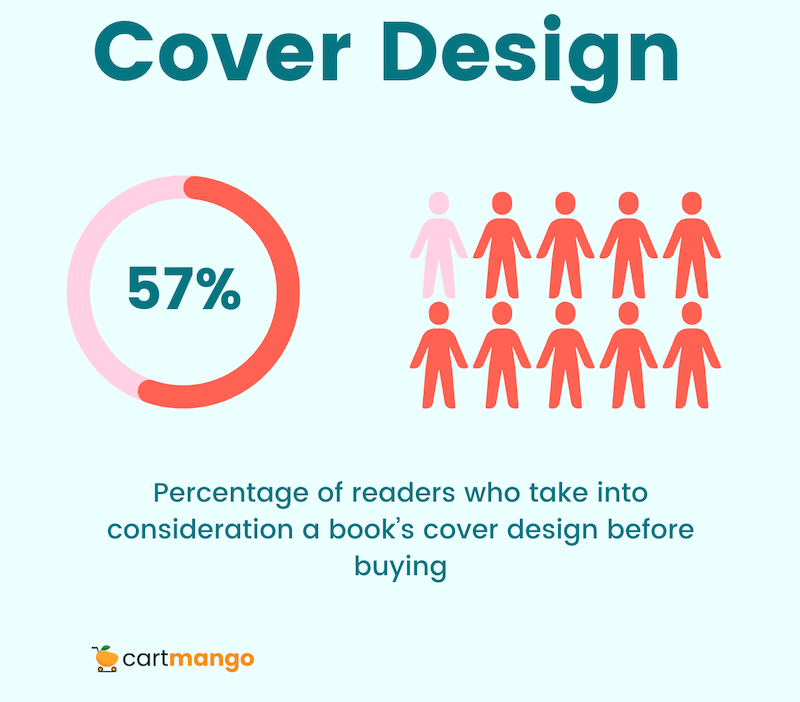
Your ebook’s design—especially its cover—significantly impacts conversion rates. 57% of readers cite cover design as a major factor in their purchase decision.
You don’t need to be a designer to create a professional-looking ebook. Tools like Canva offer templates specifically for ebook creation with customizable layouts.
Cover Design Elements:
Clear, legible title that works as a thumbnail
Subtitle that explains benefits or audience
Relevant imagery that conveys the subject matter
Color scheme appropriate to your niche (bright for self-help, subdued for business)
Your name and credentials
Professional look that matches commercial standards in your genre
Interior Design Considerations:
Consistent header and footer design
Chapter opening pages with visual interest
Appropriate use of images, charts, and graphics
Callout boxes for examples or important points
Pull quotes to emphasize key concepts
Icons or symbols for recurring elements
If design isn’t your strength, consider hiring a professional for your cover while handling interior formatting yourself. Platforms like Fiverr offer ebook cover design services starting around $40-50.
Choosing Your Ebook Format
Different ebook formats serve different purposes and platforms. Understanding the strengths of each format will help you make the right choice for your distribution strategy.
PDF (Portable Document Format):
Maintains exact layout and design across all devices
Ideal for design-heavy content, workbooks, or printable resources
Easily created from Word, Google Docs, or design software
Not reflowable for different screen sizes
Best for direct sales from your website
EPUB (Electronic Publication):
Industry standard for most ebook retailers
Reflowable text adapts to different screen sizes and devices
Supports interactive elements and multimedia
Compatible with most e-readers except Kindle
Required for platforms like Apple Books, Kobo, and Barnes & Noble
MOBI/KFX (Kindle Format):
Amazon’s proprietary format (though MOBI is being phased out for KFX)
Required for Kindle Direct Publishing
Similar features to EPUB but with Amazon-specific elements
Most popular format due to Amazon’s market dominance
For maximum flexibility, create your ebook in multiple formats. Start with a well-formatted Word or Google Doc, then convert to other formats using tools like Calibre (free) or Atticus (paid).
Editing and Polishing
Even brilliant content can be undermined by poor editing. A professional-quality ebook requires multiple rounds of editing to catch different types of issues.
Start with developmental editing to address structure, flow, and content gaps. Then move to line editing for clarity and style, followed by copyediting for grammar and consistency. Finally, proofread for typos and formatting errors.
Self-Editing Tips:
Set your draft aside for at least a week before editing
Read your content aloud to catch awkward phrasing
Use tools like Grammarly or ProWritingAid for initial checks
Create a style guide to maintain consistency (e.g., Oxford comma usage, capitalization rules)
Check all links, references, and citations for accuracy
Verify that images display correctly with appropriate captions
For professional results, consider hiring an editor with experience in your niche. Professional editing typically costs $500-2,000 depending on length and depth of editing, but significantly improves quality.
Before finalizing, enlist beta readers from your target audience to provide feedback on content value, clarity, and organization. Their real-world perspective often catches issues you might miss.
–
=== Part 2: SELLING Your Ebook ===
Setting the Right Price
Pricing your ebook strategically can dramatically impact both sales volume and revenue. The right price balances perceived value with market expectations.
Research competitor pricing in your niche to establish a baseline. Premium ebooks with specialized information typically sell for $27-97, while more general content often sells for $9.99-19.99.
Consider your goals when setting prices—lower prices generate more readers and potential leads, while higher prices signal premium value and attract serious buyers.
5 Pricing Strategies:
Value-based pricing: Price based on the transformation or value your ebook provides
Tiered pricing: Offer basic, standard, and premium versions with additional bonuses
Pay-what-you-want: Set a minimum price but allow readers to pay more if they value the content
Early-bird pricing: Start lower for eager early buyers, then increase over time
Bundle pricing: Package your ebook with other products for increased value
Test different price points with small audience segments to find your optimal price. Many successful ebook authors report finding their sweet spot through experimentation rather than market research alone.
Using a Fast and Simple Tool to Sell
If you’re a solo creator or only have a small team (1-10 people), Cartmango offers one of the most attractive (and) fastest solutions for selling your ebook directly to your audience.
Even though Cartmango is completely free for 2025, you still need to pay Stripe/PayPal fees.
Disclaimer: We’re the developer of CartMango (check the website you’re on).
Setting up your ebook for sale on Cartmango takes literally under a minute. The streamlined process eliminates the technical barriers that often prevent creators from selling directly.
Key Benefits of Cartmango for Ebook Sellers:
0 platform fees (only pay Stripe/PayPal fees)
Instant setup (under 60 seconds)
Built-in security to prevent unauthorized sharing
Setting Up Your Ebook on CartMango
1/ Create your free CartMango account here
2/ Create an offer:
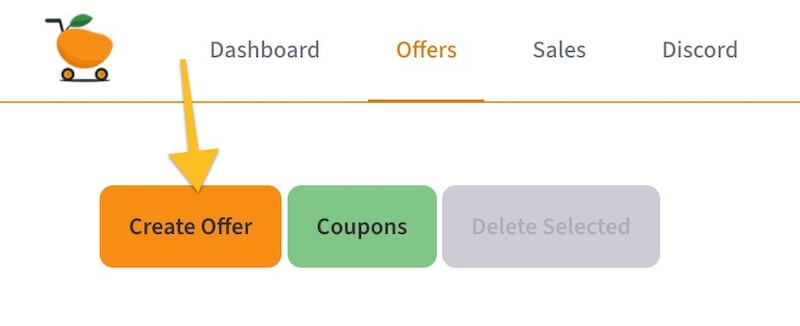
–
3/ Upload your ebook file (PDF, EPUB, or MOBI format) & set your price:
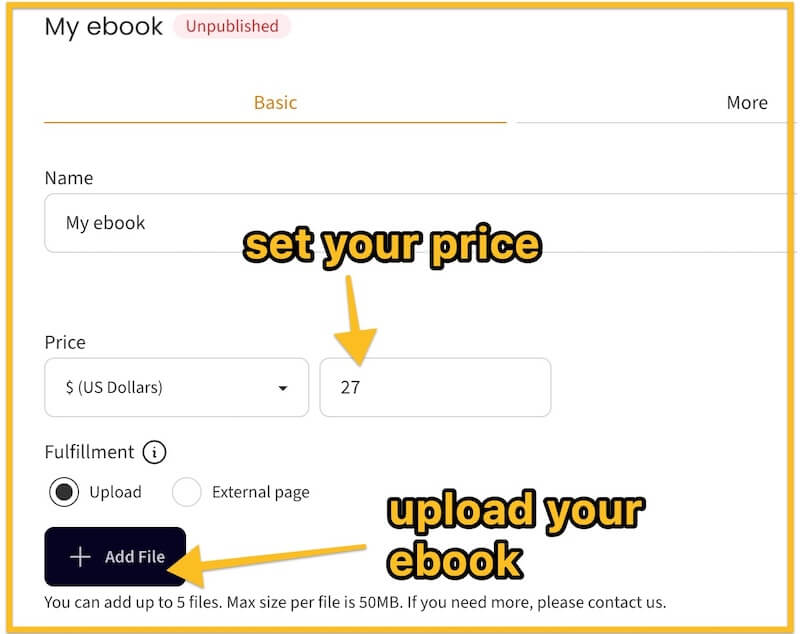
–
4/ Share your unique buy link with your audience:
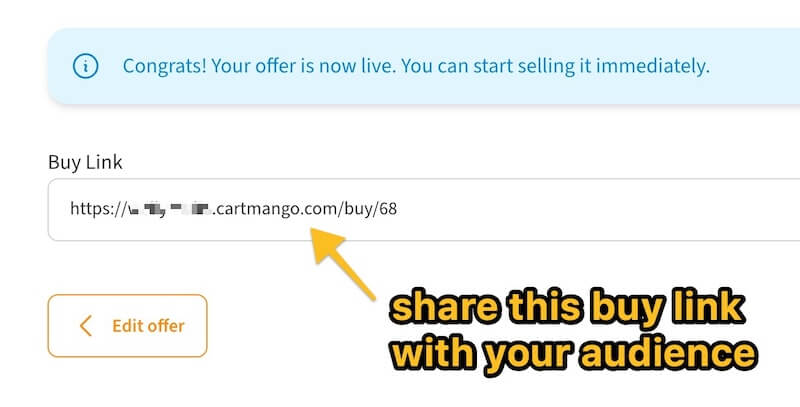
CartMango automatically protects your download links with a special one-time password system sent only to buyers’ emails, preventing unauthorized sharing and piracy. This protection is crucial for digital products like ebooks that can be easily copied.
While CartMango is ideal for individual creators and small teams, it’s totally not suitable for big comapnies with complex needs. CartMango’s USP is speed and simplicity.
Building Your Pre-Launch Strategy
Most successful ebook launches begin weeks or even months before the official release date. A strategic pre-launch campaign builds anticipation and creates momentum for your ebook’s release.
Start by creating a dedicated landing page highlighting your upcoming ebook’s key benefits, features, and release date. Include a sign-up form to capture email addresses from interested readers.
Share snippets, case studies, or excerpts from your ebook across your marketing channels. These teasers showcase the value while building curiosity about the complete content no.
Effective Pre-Launch Elements:
Early-bird pricing offers (time-limited discounts for early purchasers)
Bonus content for pre-orders (exclusive materials, templates, or resources)
Behind-the-scenes content showing your creation process
Countdown timers creating urgency as launch approaches
Email sequences building anticipation with progressive reveals
Testimonials from beta readers or advance reviewers
Pre-launch promotions usually convert better due to the combination of exclusivity, urgency, and novelty they create.
–
=== Part 3: MARKETING Your Ebook ===
Email Marketing Strategies
Email marketing consistently delivers the highest ROI for ebook promotion, with an average return of $36 for every $1 spent according to industry research by Litmus.
Your email list gives you direct access to an audience that’s already expressed interest in your content.
Begin building your list early, ideally during the pre-launch phase. Offer a valuable lead magnet related to your ebook topic to incentivize sign-ups.
Structure your email campaigns around the buyer’s journey, gradually warming subscribers toward purchase. A typical sequence might include:
Introduction and problem identification
Value proposition and social proof
Preview content and testimonials
Limited-time offer with clear call-to-action
Last chance reminder before deadline
Email Marketing Best Practices:
Use compelling subject lines that promise specific benefits
Personalize emails based on subscriber behavior and preferences
Add clear, prominent call-to-action buttons
Test different sending times and frequency for optimal engagement
Segment your list to deliver more targeted messaging
Many successful ebook marketers report that a well-structured email sequence can convert at 3-5 times the rate of social media or paid advertising campaigns.
Social Media Marketing
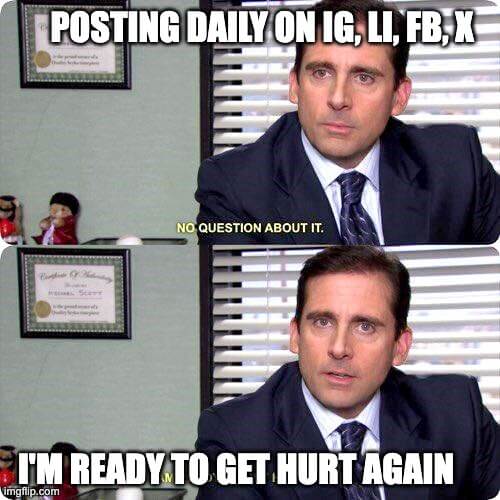
Different social platforms offer unique advantages for ebook promotion. Tailor your approach to each platform’s strengths and audience expectations.
Instagram excels for visual content like cover reveals, quote graphics, and behind-the-scenes glimpses. Use hashtags to extend your reach beyond existing followers.
LinkedIn proves especially valuable for business, professional development, or educational ebooks. Share in-depth articles about your topic, engage in relevant discussion groups, and optimize your posts with industry-specific keywords.
Facebook allows you to create a dedicated author page and join reading communities where your target audience gathers. Facebook’s detailed targeting options also make it ideal for paid promotions.
X works well for sharing quick insights, engaging with readers, and participating in trending conversations related to your topic. Pin promotional tweets to maximize visibility.
Cross-Platform Strategies:
Create a consistent visual identity across all platforms
Repurpose content in platform-appropriate formats
Schedule posts in advance to maintain a regular presence
Engage authentically with comments and messages
Track engagement to identify which content resonates most
Using a tool like Canva helps you quickly create eye-catching graphics that offer teasers or sneak peeks of your ebook’s content for social media promotion.
Content Marketing Approach
Content marketing establishes your expertise before asking for a sale. Create blog posts, videos, podcasts, or infographics that address topics related to your ebook.
These content pieces should provide genuine value while naturally leading readers toward your ebook as a more comprehensive solution. Each piece should include a clear call-to-action directing interested readers to learn more about your ebook.
Content Marketing Techniques:
Write guest posts for high-traffic websites in your niche
Create a blog series expanding on ideas from your ebook
Develop a free mini-course teaching a concept from your book
Host webinars addressing problems your ebook solves
Produce video tutorials demonstrating practical applications
Create shareable infographics visualizing key concepts
Effective content marketing doesn’t just promote your ebook—it demonstrates your expertise and builds trust with potential readers.
Influencer and Review Strategies
Partnering with influencers can dramatically extend your reach and lend credibility to your ebook.
Identify influencers whose audience aligns with your target readers and whose values match your brand.
Influencer collaborations can take many forms, from simple promotional mentions to co-created content or even contributor roles within your ebook. The key is finding authentic partnerships where the influencer genuinely values your content.
Influencer Collaboration Models:
Sponsored reviews or mentions
Affiliate partnerships with commission structures
Guest chapter contributions
Interview features within your ebook
Joint webinars or events promoting the launch
Co-branded bonus materials
Reviews provide social proof that reduces purchase hesitation. Send advance review copies to selected readers, bloggers, and industry experts with a clear timeline for feedback.
Platforms like Goodreads, BookBub, and relevant industry review sites can significantly boost visibility. Positive reviews not only convince potential buyers but also improve your ebook’s ranking in search algorithms.
Running Effective Promotions
Strategic promotions can create sales spikes and expand your reader base.
Limited-time discounts generate urgency, while bundle offers increase perceived value.
Promotional pricing works best when there’s a clear justification—such as a launch special, holiday tie-in, or anniversary celebration. This context preserves your ebook’s perceived value while providing a legitimate reason for the discount.
Promotional Tactics:
Flash sales (24-48 hours only)
Bundle deals combining your ebook with other products
Buy-one-gift-one offers encouraging sharing
Seasonal promotions tied to holidays or events
Progressive discounts (increasing urgency as deadline approaches)
Tiered pricing with premium packages including additional resources
Consider implementing an affiliate program that incentivizes others to promote your ebook. Standard commission rates range from 25-50% for digital products, reflecting their zero marginal cost.
Tracking your promotions’ performance is essential. Use unique links or coupon codes for different channels to identify which platforms and messaging generate the highest conversion rates.
–
=== Part 4: Advanced Strategies for Ebook Success ===
Analytics and Optimization
Data-driven decisions dramatically improve your ebook’s performance over time. Establish baseline metrics during your launch, then continuously test and optimize your marketing approach.
Key performance indicators to track include:
Conversion rate (visitors to buyers)
Traffic sources driving sales
Email open and click-through rates
Average revenue per reader
Refund rates
Customer acquisition cost
Use UTM parameters in your links to track where your visitors come from specifically. This helps identify which channels and campaigns deliver the best return on investment.
Testing Opportunities:
A/B test different pricing points
Compare conversion rates between sales page variations
Test various email subject lines and sending times
Experiment with different cover designs or titles
Try various promotional offers to identify optimal discounting
Analytics platforms like Google Analytics provide valuable insights into visitor behavior, while your sales platform offers purchase data. Combining these data sources gives you a complete picture of your ebook’s performance.
Regular analysis allows you to double down on what’s working while adjusting or abandoning underperforming tactics. Even small improvements in conversion rates can significantly impact your bottom line over time.
Turning 1 Ebook into Multiple Revenue Streams

Your ebook can serve as the foundation for a diverse portfolio of income sources.
With strategic repurposing, you can extract maximum value from your initial content investment.
Consider creating an audio version—the audiobook market continues to experience double-digit growth annually. Services like ACX (Audiobook Creation Exchange) connect authors with narrators and handle distribution to platforms like Audible.
Physical books remain popular despite digital growth. Print-on-demand services like Amazon Kindle Direct Publishing or IngramSpark allow you to offer paperback or hardcover editions without inventory costs or upfront investment.
Additional Revenue Opportunities:
Online courses expanding on your ebook content
Membership communities providing ongoing support
Coaching programs offering personalized guidance
Speaking engagements establishing in-person authority
Licensing your content to organizations or educational institutions
Creating supplementary products (workbooks, templates, apps)
Many successful ebook authors report that their initial ebook represents only a small portion of their total revenue, with supplementary offerings generating the majority of their income.
Legal Considerations
Protecting your intellectual property and ensuring legal compliance are essential aspects of ebook publishing that many creators overlook.
Copyright protection applies automatically to your original work, but registering your copyright provides additional legal benefits if infringement occurs. In the US, you can register through the U.S. Copyright Office for a modest fee.
For ebooks specifically, consider implementing digital rights management (DRM) technology to prevent unauthorized copying and distribution. However, balance protection with user experience—overly restrictive DRM can frustrate legitimate customers.
Critical Legal Elements:
Clear terms and conditions for purchases
Privacy policy explaining how customer data is handled
Disclaimer statements where applicable (especially for health, financial, or legal content)
International sales considerations (VAT/GST compliance)
Proper use of third-party content (images, quotes, references)
Consider creating a standard licensing agreement that outlines how buyers can and cannot use your ebook.
This clarity prevents misunderstandings and protects your content from unauthorized commercial use.
Scaling Your Ebook Business
Once you’ve successfully launched your first ebook, systematic scaling becomes possible.
Many authors find that their second and third ebooks sell significantly better as they leverage their existing audience and refined processes.
Automating your marketing and delivery systems frees up time for content creation. Email sequences, social media scheduling, and analytics reporting can all be systematized to reduce manual work.
As your catalog expands, consider creating series or collections that naturally lead readers from one book to the next.
Scaling Strategies:
Develop templates for faster content creation
Create standard operating procedures for each launch phase
Build a team of specialists (editors, designers, marketers)
Implement customer relationship management systems
Establish regular publishing schedules to build reader expectations
Expand into international markets through translations
Successful ebook entrepreneurs often describe hitting an inflection point after their third or fourth publication, where recognition and revenue begin to compound as their body of work grows.
Niche-Specific Ebook Strategies
Different niches require tailored approaches for maximum effectiveness:
| Niche | Ideal Pricing | Best Formats | Effective Marketing Channels | Unique Audience Needs | Monetization Opportunities |
|---|---|---|---|---|---|
| Education | $27-47 | PDF, EPUB | LinkedIn, Email, Education forums | Supplementary materials, actionable worksheets | Courses, certification programs, membership sites |
| Fiction | $2.99-9.99 | EPUB, MOBI | BookBub, Goodreads, Instagram | Immersive experience, series engagement | Audiobooks, series bundles, merchandise |
| Marketing | $47-97 | LinkedIn, Webinars, Industry blogs | Case studies, templates, ROI examples | Consulting, software partnerships, speaking | |
| Fitness | $17-37 | PDF, Video bundles | Instagram, YouTube, Influencer partnerships | Visual demonstrations, tracking tools | Coaching, equipment affiliates, subscription programs |
| Personal Development | $17-27 | Audio, EPUB | Podcasts, Instagram, Email | Actionable exercises, community support | Coaching, retreats, certification programs |
| Finance | $27-97 | PDF, EPUB | LinkedIn, Financial forums, Webinars | Calculators, spreadsheets, updated content | Advisory services, software tools, workshops |
| Business | $37-197 | LinkedIn, Industry events, Webinars | Implementation tools, ROI calculations | Consulting, speaking, mastermind groups | |
| Health & Wellness | $17-37 | PDF, EPUB | Instagram, Pinterest, Podcasts | Practical routines, scientific backing | Supplements, equipment, subscription services |
| Technology | $27-97 | PDF, Online access | LinkedIn, Tech forums, YouTube | Code samples, updated content | Software tools, online communities, courses |
| Cooking/Recipes | $7-27 | PDF, Print | Instagram, Pinterest, YouTube | Visual content, ingredient substitutions | Cooking tools, ingredient partnerships, video courses |
This comparison can help you position your ebook effectively based on established niche patterns while identifying opportunities to differentiate your offering.
–
3 Real-Life Success Stories
Learning from those who’ve achieved remarkable results can provide both inspiration and practical strategies.
1/ Honorée Corder
Honorée Corder’s book, “You Must Write a Book,” became the cornerstone of a thriving business ecosystem that includes courses, coaching, and speaking engagements. Through her strategic efforts, she has sold nearly 5 million copies of her self-published books, generating several million dollars in revenue.
Source: Honorée Corder’s Website
2/ Nathan Barry
Nathan Barry
Nathan’s “Authority” ebook about self-publishing earned over $150,000 in its first year. He leveraged his experience to create ConvertKit, now a multi-million dollar email marketing platform.
Source: Nathan Barry’s Site
3/ Joanna Penn
Joanna’s non-fiction ebooks on writing and self-publishing generate substantial passive income alongside her fiction work. Her transparency about the business has made her a trusted authority, with her ebooks serving as entry points to her courses and services.
Source: The Creative Penn
–
These success stories share common elements: quality content solving specific problems, strategic marketing focused on clear audience needs, and expansion beyond the initial ebook into complementary products and services.
–
How to Make and Sell an Ebook – TL;DR
Creating and selling an ebook can feel overwhelming at first, but breaking it down into manageable steps makes the journey clear and achievable.
Based on everything we’ve covered, here’s your simplified 5-step action plan to ensure your ebook succeeds:
Step 1: Choose a Topic Your Readers Actually Want
Start by clearly identifying who your readers are and what they need.
Research popular topics in your niche, look at competitors’ ebooks, and engage with your audience through surveys or social media polls. Picking the right topic ensures there’s demand for your ebook from day one.
Step 2: Leverage Existing Content to Save Time
Don’t reinvent the wheel—use content you’ve already created.
Gather relevant blog posts, newsletters, videos, or podcasts you’ve published before. Organize and expand this content into a cohesive ebook that provides deeper value than your free materials.
Step 3: Format and Design Your Ebook Professionally
Your ebook’s presentation matters greatly.
Choose user-friendly tools like Canva or Google Docs to create attractive layouts, clear formatting, and professional covers. Make sure your ebook looks great on all devices by testing thoroughly before release.
Step 4: Sell Smart Using the Right Platform
For solo creators or small teams, CartMango is a great free choice for 2025—it’s quick to set up, has no platform fees (you only pay Stripe or PayPal fees directly), and protects your ebook from piracy.
If you have a larger team or more complex needs, CartMango isn’t for you though.
Step 5: Market Your Ebook Strategically
Marketing is key to driving sales.
Build excitement with a pre-launch campaign, leverage email marketing to nurture leads, promote actively on social media channels relevant to your niche, and consider influencer collaborations to expand your reach. Don’t forget to track results closely so you can optimize your marketing efforts over time.
–
By following these 5 steps consistently, you’ll position yourself for ebook success in 2025 and beyond.
Remember—each successful ebook strengthens your authority, expands your audience, and opens doors to new opportunities.
Now it’s time to put this plan into action… your future readers are waiting.
Related Reading
- 8 ThriveCart Alternatives & The Lifetime Pricing Paradox (2025)
- 8 SamCart alternatives + Subscription hostage (2025)
- The GENTLE Method: Soft marketing for creators
- How Far in Advance Should You Promote a Webinar?
- The SAVINGS Method: The Productivity Improvement Plan for Creators
- 9 Questions to Ask: How to Hire a Digital Marketing Agency
- Decision That Costs Millions? Marketing Funnel vs Customer Journey
- Audit Your Growth Funnels in 10 Minutes
- 67 Funny podcast topics + The Unlimited Topics Method
- The 365-day exit plan: How to leave your corporate job
